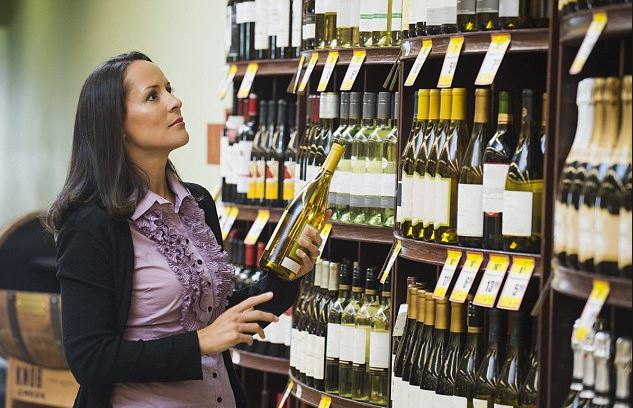
27 Jul PICKING THE BEST WINES AT YOUR LOCAL MARKET
Down the aisle of the supermarket, in a long row, stands a genuine army of wine, bottle after bottle, side by side, stretching from here to there. Instead, you saw only 30 bottles– many under $10– and you could feel confident that any one of them would make your dinner tonight sing?
We often mention wine stores, but we know that most people buy wine at supermarkets. We’d go into the supermarket to pick up something for dinner, and then wheel over to the wine aisle to look for something new.
It isn’t possible to do this everywhere– state laws forbid supermarkets in New York to sell wine, for instance– but, still, almost half the wine bought in stores is acquired at grocery stores and “supercenters,” those huge stores that also sell food, according to ACNielsen Homescan. Warehouse club stores account for an additional 10 %.
Selling wine and food at the same place makes such good sense. Wine is a beverage to serve with food, and having an aisle of wine next to the macaroni and cheese not only makes wine shopping easier, but it makes an important statement about wine’s place on the table.
Different Every Night
Think how hard we try to get something a little bit different to make for dinner every night. Even if we eat chicken often, we have whole roast chicken one night, mushroom chicken another night and cold chicken salad on still another. Wine can help make every dinner different and a little special.
As we’ve written before, some supermarkets take their wine seriously and offer excellent selections and expert service. And, of course, large stores such as Costco are offering more and better wines all the time. For now, let’s talk about the plain-old, garden-variety, chain-supermarket aisle– the kind we grew up with and most people live with.
We’ve shopped for wine in supermarkets in several states for decades like Maine, and we have some long-held thoughts about decoding the aisle. Here’s our advice:
1. Stop for a minute and get your bearings. Supermarket wine aisles are often organized strangely. Sometimes wines are grouped by producer, sometimes by type, and sometimes by both. That means California Sauvignon Blanc, for instance, might be on different shelves. Some stores have sections for “fine wine,” separated from other wines, but don’t take their word for it.
2. Disregard the larger bottles, the boxed wines, and the frat-boy stuff. Sure, some fine wines come in big bottles, but most of these are mass-produced jug wines that, in tastings, we haven’t much enjoyed. This will immediately make the aisle much smaller, especially given the size of the huge boxed wines. And yes, some frat boys know their wines, but you want something special with dinner, so throw out those things and all of the bad stuff on the lower shelves.
3. Disregard all the Chardonnay. We know most people like Chardonnay, and so do we. But Chardonnay’s popularity means the aisles are flooded with it. You’ve once again narrowed your choices considerably if you simply pass over that part of the aisle. (If you want a Chardonnay, look for one that you don’t see every day. We found a Pedroncelli from Sonoma that was crisp and refreshing for $9.49.).
4. Disregard the familiar. You will be punished– price-wise– for refusing to leave your comfort zone. Santa Margherita Pinot Grigio was at least $20.19 at every store we visited, far more than better wines, and that pattern was repeated over and over. Had a Petite Sirah recently? Several stores had Bogle Vineyards’ good example of this brawny red varietal for just $9.99.
5. Think outside California. There are some excellent California wines on shelves, of course, but you’ll probably get better deals on wines from elsewhere– from Washington State to Australia. We saw a remarkable number of very good Australian wines on shelves, many just $6.99 a bottle. One store even offered a few wines from South Africa, including a very drinkable Roodeberg red wine, from the big KWV cooperative, for $10.99.
6. Think Beaujolais and Pinot Noir. Every store had at least one Beaujolais, the lively, fruity red from France that’s good with just about all food and costs about $8. And every store had at least two U.S. Pinot Noirs. These are extremely versatile with food, and they tend to be better buys than Cabernet Sauvignon or Chardonnay because they aren’t as popular.
7. Look closely at vintages. As you know, we don’t care much about whether one year was “better” than another. But most wines in supermarkets are for immediate enjoyment. You want them fresh and young, from the most recent vintage available. Unfortunately, at many supermarkets, wines stand on the shelves until they’re sold and, like milk, the older stuff is moved to the front. We saw three-year-old White Zinfandels and Pinot Grigios and a 1996 Pouilly-Fuisse. We saw several vintages of the same wine standing right next to each other. At one store, a 1999 Georges Duboeuf Beaujolais-Villages was next to a 2001, identical except for the vintage. You want the newer one, which is sometimes lurking behind the older one. Sometimes, you can find fine old bottles from great years that are real bargains because the store never raised the price. That’s how we once bought a few bottles of 1974 Robert Mondavi Cabernet Sauvignon, a classic wine. At one store, we picked up three different vintages of reliable Cambria Pinot Noir, for $22.99 each.
8. Look for orphans. Some of our best supermarket deals over the years have come because there’s one bottle of something left, and there’s no place for it on the shelves. At one store, there was one bottle of Mumm’s Cordon Rose Champagne. There are often good buys like that if you’ll search (often behind other bottles).
9. Bigger isn’t necessarily better. Some supermarkets that have more space devoted to wine have thinner selections. They display bottle after bottle of the same exact mass-produced wine, like a valley of the clones that swallows up space for the good stuff.
10. Check prices. That might seem obvious, considering that some of us note whether one store charges more for a can of peas than another. But too many people assume that wine prices are fairly stable, and they aren’t. Stores compete on wine prices just like anything else. At the stores we visited, Sutter Home White Zinfandel ranged from $3.89 to $5.49, a 41 % difference. The same is true for many other wines.
Now, having decoded the shelves, how many bottles are left to choose from? Probably not many. And if you’re looking for wine in a specific price range, or if you’re looking just for a red or a white, it will be even fewer. Among those that are left, close your eyes and pick one. Something new will make dinner more fun.



No Comments